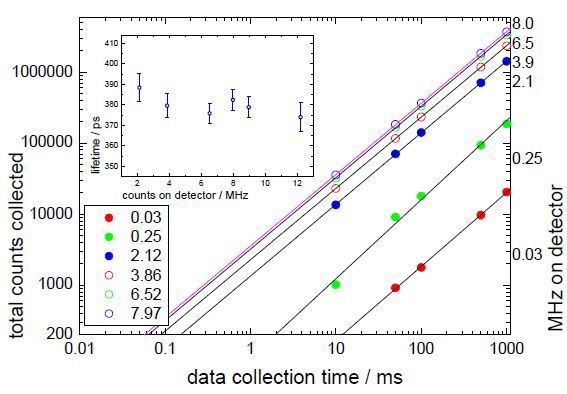Sponsored by HORIBADec 16 2013
The rapid and efficient collection of photons emanating from the fluorescence emission of a sample is a goal of fluorescence lifetime spectroscopy using time-correlated single-photon counting (TCSPC). Historically, TCSPC was considered to be a highly sensitive method for fluorescence lifetime determination but often requires long data acquisition times. This aspect was mainly related to source technology (repetition rate limitations) and the 2% start to stop ratio restriction.
With the improvement in excitation source technology and repetition rates increasing from kHz to several MHz, the dead time of the timing electronics has become significant. The ability to acquire data rapidly and efficiently is demonstrated by the coupling of a high repetition rate (up to 100MHz) DeltaDiode lasers with low dead time data acquisition electronics, FluoroHub and DeltaHub.
TCSPC Data Acquisition
Schematic representation of time-correlated single-photon counting (TCSPC) is shown in Figure 1. The key determining factors in relation to the time resolution are the optical pulse width and the transit time spread of the detector. The timing electronics are also influential and their dead time affects the efficiency of the data collection process.

Figure 1. Schematic representation of a TCSPC set up
The advent of high repetition excitation sources implies that the processing speed of the timing electronics is presently critical for quick and efficient data collection. The ability of sources such as the DeltaDiode to operate up to 100MHz requires the timing electronics to be capable of accepting pulses separated by 10ns. This implies that the dead time must be similar and which had not been the case traditionally.
Newer electronics, such as the DeltaHub and FluoroHub-B are examples of units with very short dead time (<10ns). Figure 2 shows the difference in efficiency of converting a “stop” photon into a histogram point for different count (stop) rates with an excitation rate of 5MHz.

Figure 2. Difference in converting a stop event into a histogram count, between a traditional time to amplitude converter based electronics and a DeltaHub.
It can be seen from this figure that at lower stop rates the two systems are very similar, but at higher rates the traditional system is less efficient which relates to its longer dead time.
Efficient Data Acquisition with 100MHz Excitation Rate
Fluorescence lifetime imaging is a possible application where a rapid and efficient data acquisition is required. This enables imaging to be performed on samples that may move position (eg cells in solution) and where photo- bleaching may be an issue. In this application, data is not taken to such a high a precision as with cuvette based measurements. Presently the longest life time that can be measured at this rate is less than 2ns in order to avoid re-excitation of the sample before it has fully decayed.
As a model system, a dye with a lifetime of approximately 380ps was chosen and the effect of different count rates on the detector ascertained for different collection times. The outcome, along with the recovered lifetime values is shown in Figure 3, with an excitation rate of 100MHz.

Figure 3. Effect of collection rate and time on the number of counts obtained and the lifetime (inset). Linear fits are shown for the data points
It can be seen that within error limits the lifetime value is the same in all cases. It is hence observed that under these conditions for this sample, the influence of pulse pile up is negligible. The linearity also shows that the collection process is efficient.
Considering the fact that around 200 counts are required to fit a monoexponential decay within a 10% error then it can be estimated that a data collection time of 60µs should be sufficient to model a single exponential decay. For verifying this, decay was measured as seen in Figure 4.
The lifetime is determined using reconvolution analysis and found to be in agreement with the other measurements. This is an example of an extremely rapid TCSPC acquisition and demonstrates the ability of the technique to follow short dynamic processes.

Figure 4. Fluorescence decay measured in 60μs, along with instrumental response and fitted function. The weighted residuals are also given. The recovered lifetime was 366ps.
Conclusion
The combination of a high repetition excitation source combined with low dead time electronics enables the fast and efficient collection of time-resolved fluorescence data. This can be important in the area of microscopy and where fast dynamic processes need to be studied. T
The results shown in this note acknowledge the following paper,D. McLoskey, D. Campbell, A. Allison and G. Hungerford, 2011. Fast time-correlated single-photon counting fluorescence lifetime acquisition using a 100 MHz semiconductor excitation source. Meas. Sci. Technol. 22, 067001.

This information has been sourced, reviewed and adapted from materials provided by HORIBA.
For more information on this source, please visit HORIBA.